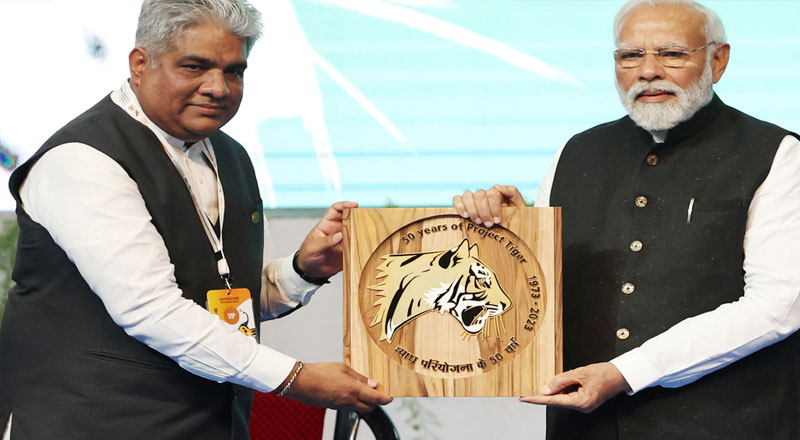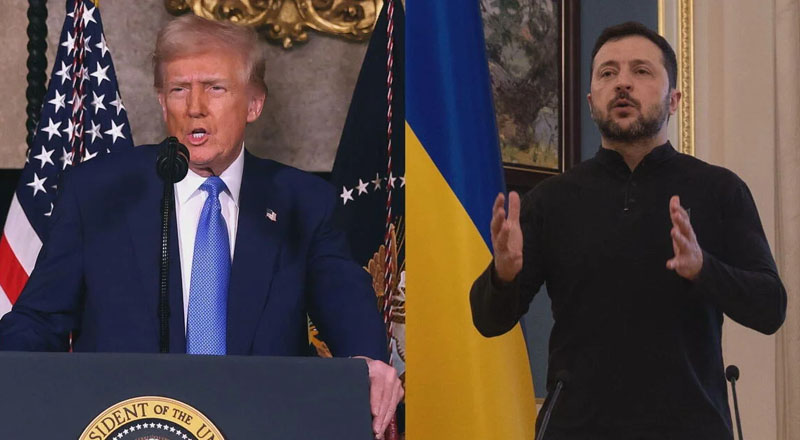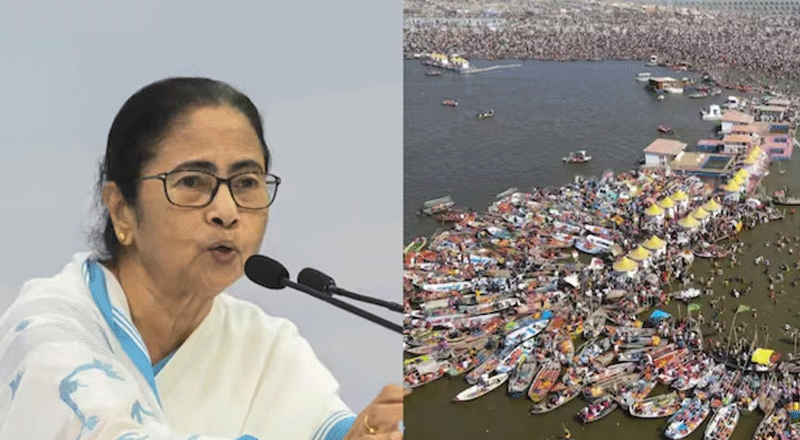My colleagues in the Union Cabinet Shri Bhupender Yadav ji, Shri Ashwini Kumar Choubey ji, ministers from other countries, ministers from states, other representatives, ladies and gentlemen!
At the outset, I want to apologize to all of you that I am late by an hour. I left at six in the morning; I thought that I would be back after visiting the forests on time. I apologize for keeping you all waiting. It is a proud moment in view of the new number of tigers; this family is expanding. I request all of you to give a standing ovation to the tiger. Thank you!
Today we are witnessing a very important milestone. Project Tiger has completed 50 years. The success of Project Tiger is a matter of pride not only for India but for the entire world. India has not only saved the tiger, but has also given it an excellent ecosystem to flourish. It is even more pleasant for us that India is home to 75 percent of the world’s tiger population in the 75th year of India’s independence. It is also a coincidence that the tiger reserve in India is spread over 75,000 square kilometers and the tiger population has also increased by 75 per cent in the last 10-12 years. This has been possible due to everyone’s efforts and I congratulate the entire country for this success.
Friends,
Today, the wildlife lovers around the world are bewildered that at a time when the population of the tigers is stagnant or decreasing in many countries, then how come it is increasing rapidly in India. The answer is hidden among the traditions and culture of India and its natural urge towards biodiversity and environment. We do not believe in conflict between ecology and economy, but give equal importance to co-existence of both. We have thousands of years of old history related to tigers. The graphical representations of tigers have been found on the ten-thousand-year-old rock art in Madhya Pradesh. Many communities of the country, like the Bharias living in Central India and the Worlis living in Maharashtra, worship the tiger. Tiger is considered as our friend and brother in many tribes in our country. And, the tiger is the vehicle of Maa Durga and Lord Aiyappa.
Friends,
India is a country where protecting nature is part of culture. This is why it has many unique achievements in wildlife conservation. With only 2.4 per cent of the world’s land area, India contributes about 8 per cent of the known global biodiversity. India is the largest tiger range country in the world. With nearly 30,000 elephants, we are the largest Asiatic elephant range country in the world! Our rhino population of nearly 3,000 makes us the largest single-horn rhino country in the world. We are the only country in the world to have Asiatic lions. The lion population has increased from around 525 in 2015 to around 675 in 2020. Our leopard population went up by over 60 per cent in just 4 years. The work being done to clean up rivers such as the Ganga has helped bio-diversity. Some aquatic species that were considered to be in danger have shown improvement. These achievements are all due to people’s participation and a culture of conservation, ‘Sabka Prayas’ (collective efforts).
For wildlife to thrive, it is important for ecosystems to thrive. This has been happening in India. While celebrating 75 years of independence, India added eleven wetlands to its list of Ramsar sites. This took the total number of Ramsar sites to 75. Forest and tree cover are also increasing. India added over 2,200 square kilometers of forest and tree cover by 2021, when compared to 2019. In the last decade, the number of Community Reserves increased from 43 to over 100. In a decade, the number of National Parks and sanctuaries around which Eco-sensitive Zones were notified increased from nine to 468.
Friends,
I have had the benefit of my long experience in Gujarat as far as these wildlife conservation efforts are concerned. When I was the Chief Minister of Gujarat, we worked on the population of the lions. I learned that limiting to just one geographical area cannot save a wild animal. It is necessary to create a relationship between the local people and the animal. And this relationship should be based on emotion as well as economy. Therefore, we launched the Wildlife Mitra program in Gujarat. Under it, the incentive of cash reward was offered to monitor activities like hunting. We also opened a rehabilitation center for the Lions of Gir. We also recruited women-beat guards and foresters in the Forest Department in Gir area. This helped in strengthening the spirit of ‘Lion Hai to Hum Hai, Hum Hai to Lion Hai’. Today you can also see that a huge ecosystem of tourism and ecotourism has now been established in Gir.
Friends,
Like the initiatives taken in Gir, the success of Project Tiger also has many dimensions. As a result, tourist activity also increased and there was a huge reduction in man-animal conflicts in Tiger Reserves due to the awareness programs that we ran. The number of tourists in Tiger Reserves has increased due to big cats and this has strengthened the local economy. The presence of big cats has made a positive impact on the lives and ecology of the local people.
Friends,
A few months back, we also took another important initiative to enrich India’s biodiversity. The cheetah became extinct in India decades ago. We brought this magnificent big cat to India from Namibia and South Africa. This is the first successful trans-continental translocation of a big cat. A few days back, four beautiful cubs were born in Kuno National Park. The cheetah became extinct from Indian soil about 75 years ago. In other words, a cheetah has taken birth on the land of India after about 75 years. This is a very auspicious beginning. This is also proof of how important international co-operation is for the protection and prosperity of biodiversity.
Friends,
Wildlife protection is not a one-country issue, but a universal one. International Alliance is the need of the hour in this regard. I called for an alliance against poaching and illegal wildlife trade in Asia on Global Tiger Day in 2019. The International Big Cat Alliance is an extension of this spirit. It will help mobilize financial and technical resources for the entire ecosystem associated with the big cat. It will also be easier to implement the conservation and protection agenda that has emerged from the experiences of various countries, including India. The focus of the International Big Cat Alliance will be on the conservation of seven major big cats of the world. The countries which have Tiger, Lion, Leopard, Snow Leopard, Puma, Jaguar and Cheetah will be a part of this alliance. Under this alliance, the member countries will be able to share their experiences and they will be able to help their fellow country more quickly. This alliance will also lay emphasis on Research, Training and Capacity Building. Together we will save these species from extinction and create a safe and healthy ecosystem.
Friends,
A better future for humanity is possible only when our environment remains safe and our bio-diversity continues to expand. This responsibility belongs to all of us, to the entire world. We are continuously encouraging this spirit during our G-20 presidency. The G20 motto, ‘One Earth, One Family, One Future’, conveys this message. At COP26 too, we have set big and ambitious goals for ourselves. I have full faith that we will achieve every goal of environmental protection with mutual cooperation.
Friends,
I would also like to say one more thing to the foreign guests and our guests from other states attending this program. You must take advantage of one more thing here. There is the region of Sahyadri, the region of Western Ghats, where many tribes live. For centuries, they have been engaged in enriching every bio-diversity, including tigers. Their life and their culture is a very good example for the whole world. We get to learn from this tribal tradition how to create a balance of give and take with the Nature. I also got late as I was talking to many colleagues who are working in this direction. ‘The Elephant Whisperers’ documentary, which won an Oscar, also reflects our heritage of the amazing relationship between Nature and Creature. The lifestyle of the tribal society also helps a lot in understanding the vision of Mission LiFE i.e. Lifestyle for Environment. I urge you to definitely take something from the life and tradition of our tribal society for your country and your society. Once again, I express my gratitude to all of you for attending this event. I assure you that we will better this new figure of tigers in the near future and make new achievements.
Thanks a lot!





